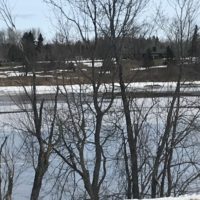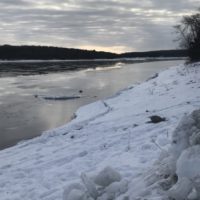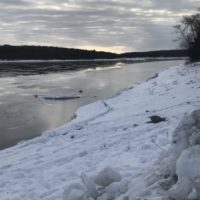Just wanted to post a few observations from the last week at Birchdale and answer some questions people have had.
This past week a few people asked if I’ve seen some real circus acts at the ramp. The answer is not really. It seems like most folks that have been here this week have either done this before or are experienced in the sense that they fish multiple times a year in various conditions so this is kind of a checklist and some reminders to help you have a better trip.
Most of what I have to say here will apply when the temps are cold enough to ice up the ramp and the past few days have been cold, especially in the morning. Also the wind has picked up mid morning to noon most days and that adds to the stress in a few different ways at the ramp and on the water.
The county would like me to be there when the number of boats warrants it. Saturday morning, even though it was cold and windy, I reasoned because it was Easter weekend and more people are likely to have extra time off, it would still be busy enough to be there. There were 5 boats by 10:30 am so I’m guessing the snow south of us and the miserable conditions on Friday had something to do with that.
As far as ice on the ramp make sure you’re in 4WD and then the best thing you can do is when you go back up the ramp make sure to stop as soon as your trailer wheels are out of the water and let the trailer (and boat if you’re leaving) drain well. Some trailers take a good minute to drain. It’s okay to remind those before you and after you to do the same. Just because somebody doesn’t stop doesn’t mean they’re an idiot. Oftentimes people are excited to get on the water, most for the first time, and just don’t think about it. My goal is that every 4WD vehicle makes it back up on their own power. If you don’t have 4WD it might be iffy when it’s cold enough to make ice.
If there’s ice at the water’s edge remember to break it up before backing your trailer in the water or it will take your trailer lights out. Yesterday morning because of a lack of activity, ice was forming in an hour. Fortunately the guy who took his lights out yesterday wanted to install LED’s anyway.
Another thing to think about is if there is a weak link so to speak in your boat, trailer, or anything concerned with either, cold temps will reveal it, especially 0-15 degrees. If you start your outboard at home to make sure everything is okay make sure the water is drained out of the motor. Several water pumps/impellers have been frozen or otherwise not working. Some dry start their motors just before putting them in which isn’t a bad idea. However I could not do that with my last outboard without destroying the impeller in cold or warm temps so don’t expect everyone to do that.
It’s not a bad idea to have starting fluid, some tools (spark plug wrench, screw drivers, knife, etc) and jumper cables or power pack available. Start the outboard in the water before unhooking the boat to make sure and then back off and then let it warm up good. Most motors take some time to warm up in the cold and run like you’re use to having them run.
Several glass and aluminum boats that were fishing the previous day have been frozen to the bunks the following morning. I’m not sure what to do about that. I saw a bunk trailer yesterday with the nylon strips on top of the bunks and they had no problems. Carpeted bunks are nice but they also hold water and freeze quickly to a hull.
If you put you put your trolling motor down it may ice up and want to stay in that position. You’ll get it up again but it might not be easy.
Lines and rod guides icing up has been a common problem this week so you might try rubbing some chapstick/lip balm on the guides and tip or whatever you have found that works.
Fishing on the Canadian side. If you have in your immediate possession a current Ontario license and outdoors card, no live bait (except crawlers in artificial bedding), no alcohol, are following the Ontario boating regulations and follow the proper border crossing procedures then you’re close. I’m not going to address the border crossing and return regulations and ask that you don’t either unless you work for US or Canadian customs or Border Patrol. There have been some recent changes and I have several friends who work for US Customs who I’ve discussed this with and it is still not perfectly clear to me – at least not clear enough to offer anyone advice. Personally I have a current Remote Access Border Crossing permit from Canadian immigration and the US I68 and carry it on the boat. It’s not my intent to scare or discourage anyone from fishing across the line but if you are in violation it’s not going to cheap or easy. And by the way the fish don’t prefer one side or the other.
There is no border identification or markers so if you don’t have the things above in order, stay on the Minnesota side. If you don’t have a GPS make friends with somebody close who can advise you. If you do have a GPS don’t fish right on the line. Please respect their country and their laws. I have friends who don’t like this or that about their regs and laws and while we’re still friends, we don’t fish in Canada together. I value the privilege of being able to travel and fish there far too much to mess it up.
Lastly…. PLEASE PLEASE WEAR your Personal Flotation Device. Yes I just yelled at you. If you have one but hate it buy something you do like and can wear for a day – float coat, auto inflatable – whatever you don’t mind wearing and will keep you floating until you can get to safety. I bought an auto inflatable a couple years ago and like the compactness. I consider myself a pretty good swimmer but have never attempted swimming with clothes and footwear but I’m 99% sure I wouldn’t make it. Going under in 33 degree water would probably take your breath away. I would imagine several layers plus any sort of insulated footwear just compounds the difficulty exponentially. There are lots of things that can go wrong. You have more gear in the boat than normal with clothes, heaters, propane tanks, etc – stuff to trip over. The boat floor can get slippery. One misstep or trip can put you in the water. Think of it like insurance – you may not use it very often if ever, but when you need it you really need it.
This is getting very long but it still doesn’t cover everything. My purpose is to help you be prepared and have a good safe trip.
One more thing – the high schooler who shuttles people back and forth from the landing to your parked vehicle – he doesn’t work for the county or state. I talked to his dad the other day and this is his 6th year of doing this as a courtesy. Please give him a tip. I’ve noticed some do and some don’t and am guessing those who don’t think the county pays him. What he does for you is at least as important or more so as what I do! Nobody really likes to have to walk back to their vehicle either in the beginning or end of the day so his service really takes the edge off of some folks who are anxious about maximizing their time on the water. When he’s not there he’s either in school or working one of his 2 jobs. No he’s not related to me. This is a plug for a young man who saw a need and did something about it.


